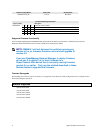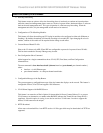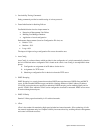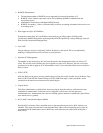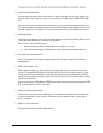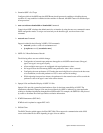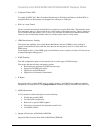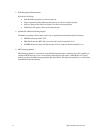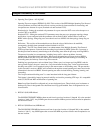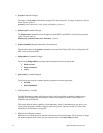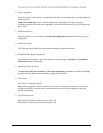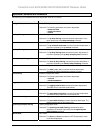8 System Firmware Version 3.2.0.6
¾ Granular OSPF v2/v3 Traps
Configure which of the OSPF traps the OSPF Router should generate by enabling or disabling the trap
condition. If a trap condition is enabled and the condition is detected, the OSPF router will send the trap to
all trap receivers.
¾ auto-cost reference bandwidth and bandwidth Commands
Controls how OSPF calculates the default metric for an interface by using the auto-cost command in router
OSPF configuration mode. To assign cost-based only on the interface type, use the no form of this
command.
¾ network area Command
Support is added for the following 2 OSPFv2 CLI commands:
• network ip-address wildcard-mask area areaid
• ip ospf area areaid [ secondaries none ]
¾ OSPF v2/v3 Route Preferences Rework
The following effects are seen with this change:
• Configuration of external route preference that applies to all OSPF external routes (like type1,
type2, nssa-type1, nssa-type2) equally.
• Allows multiple route types to be configured with equal preference values.
• No longer follows the order among OSPF route preferences: intra < inter < external.
• Configuring the route preference of 255 makes the route ineligible to be selected as the best route
to its destination (a route with preference of 255 is never used for forwarding).
• While migrating from previous releases, the preference for the external routes will be set with the
preference value of the type-1 route in the earlier releases.
¾ Opaque LSAs and Detailed Display of OSPF v2 LSAs
Opaque LSAs provide a generalized mechanism to allow for the future extensibility of OSPF. The
information contained in Opaque LSAs may be used directly by OSPF or indirectly by some application
wishing to distribute information throughout the OSPF domain. For example, the OSPF LSA may be used
by routers to distribute IP to link-layer address resolution information.
¾ ICMP Enhancements (RFC4443)
ICMPv6 code is updated to support RFC 4443.
¾ DNSv6 Client
The DNS Client has added support for IPv6 (RFC3596). The transport for communication with a DNS
server can be either IPv6 or IPv4 depending on type of server address.





